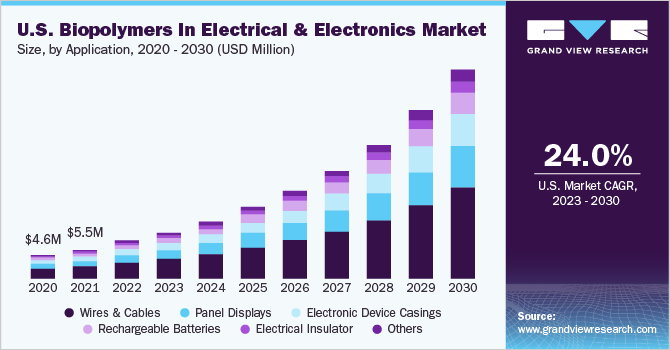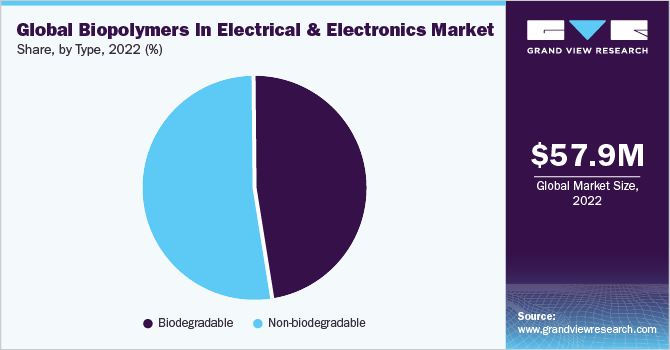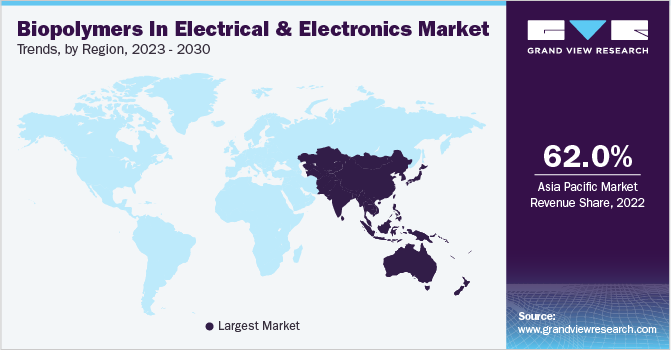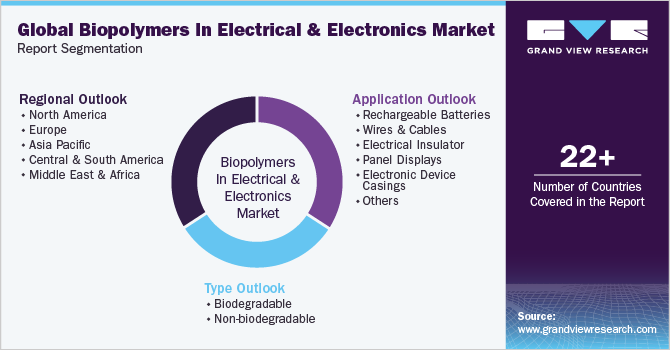- Home
- »
- Plastics, Polymers & Resins
- »
-
Biopolymers In Electrical & Electronics Market Report, 2030GVR Report cover
![Biopolymers In Electrical & Electronics Market Size, Share & Trends Report]()
Biopolymers In Electrical & Electronics Market Size, Share & Trends Analysis By Type (Biodegradable, Non-biodegradable), By Application (Rechargeable Batteries, Wires & Cables), By Region, And Segment Forecasts, 2023 - 2030
- Report ID: GVR-4-68040-123-5
- Number of Report Pages: 120
- Format: PDF, Horizon Databook
- Historical Range: 2018 - 2021
- Forecast Period: 2023 - 2030
- Industry: Bulk Chemicals
Report Overview
The global biopolymers in electrical & electronics market size was valued at USD 57.96 million in 2022 and expected to grow at a compound annual growth rate (CAGR) of 24.0% from 2023 to 2030. The demand for biopolymers across the electrical & electronics industry is propelled by the adoption of green procurement policies by electrical & electronics manufactures and changing consumer preferences towards eco-friendly commodities. Furthermore, the electrical & electronics industry is one of the major utilizers of biopolymers for the manufacturing of their applications such as wires & cables, electrical insulators, rechargeable batteries, panel displays, and others. Rising concerns for environment protection has propelled the manufacturers to introduce the utilization of biopolymers for the manufacturing of their applications.

Expanding composting infrastructure and rising governmental efforts to reduce landfilling are anticipated to augment the demand for biopolymers across the electrical & electronics industry over the forecast period. Biopolymers such as polylactic acid (PLA) and polybutylene adipate terephthalate (PBAT) are being increasingly used for manufacturing of wires & cables and other products.
Furthermore, increasing disposable income and rising demand for electronics across the U.S. population has propelled the demand for biopolymers for the manufacturing of casings for electronic devices. In addition, with increasing in the building & construction projects to provide the population with affordable housings, the demand for wires & cables has increased, which in turn is anticipated to propel the demand for biopolymers in electrical & electronics across the U.S. market.
Type Insights
Non-biodegradable plastics dominated the biopolymers in electrical and electronics market across the type segmentation in terms of revenue, accounting to a market share of over 52.0%. Non-biodegradable plastics such as polyethylene (PE), polyethylene terephthalate (PET), and polyamide (PA), are non-complex resins to be manufactured and have a longer life span, which has propelled their demand across the electrical & electronics industry.

Furthermore, biopolymers such as PLA and PET are being utilized for the manufacturing of printed circuit boards (PCB). In addition, green electronics has witnessed rise in traction with the introduction of biopolymers for the manufacturing of inject and screen printing, dip coating, and others.
Application Insights
Wires & cables dominated the market across the application segmentation in terms of revenue, accounting to a market share of over 42.0%. This is followed by the rising growth of global building & construction industry, which is a major utilizer of wires & cables. Hence the demand for biopolymers for the manufacturing of wires & cables is anticipated to propel during the forecast period.
Followed by the advancement in technology, electronic manufactures are prominently introducing advance electronic device such as cell phones, television, and others. Panel displays have introduced the utilization of biopolymers such as PE, PET, and PA.
Regional Insights
Asia Pacific in regions dominated the market and accounted for a revenue share of over 62.0% in 2022. Followed by inexpensive manufacturing of electronics devices, rising disposable income, and rising demand for the growing population across the region is anticipated to propel the demand for biopolymers across electrical & electronics industry.

Furthermore, rising demand for affordable housings has propelled the demand for wires & cables which is anticipated to increasing the demand for biopolymers during the forecast period. Additionally, presence of major electrical & electronics manufacturers is further anticipated to boost the demand for biopolymers across the region.
Key Companies & Market Share Insights
Research activities across the market is focused on new materials, which combine several properties, are projected to gain wide acceptance in this industry in the coming years. Some of the key players in the global biopolymers in electrical & electronics market are:
-
SABIC
-
BASF SE
-
Trinseo
-
Braskem
-
TEIJIN LIMITED
-
Toyota Tsusho Corporation
-
NatureWorks LLC
-
Total Carbion PLA
-
Solvay
-
Futerro
Biopolymers In Electrical & Electronics Market Report Scope
Report Attribute
Details
Market size value in 2023
USD 69.55 million
Revenue forecast in 2030
USD 313.41 million
Growth Rate
CAGR of 24.0% from 2023 to 2030
Base year for estimation
2022
Historical data
2018 - 2021
Forecast period
2023 - 2033
Quantitative units
Volume in tons; revenue in USD thousand/million, and CAGR from 2023 to 2030
Report coverage
Revenue and volume forecast, company profiles, competitive landscape, growth factors, and trends
Segments covered
Application, type, region
Region scope
North America, Europe, Asia Pacific, Central & South America, Middle East & Africa
Country scope
U.S.; Canada; Mexico; Germany; UK; France; Italy; Netherlands; Spain; China; India; Japan; South Korea; Australia; Indonesia; Thailand; Vietnam; Brazil; Argentina; Saudi Arabia; United Arab Emirates (UAE); South Africa
Key companies profiled
SABIC; BASF SE; Trinseo; Braskem; TEIJIN LIMITED; Toyota Tsusho Corporation; NatureWorks LLC; Total Carbion PLA; Solvay; Futtero
Customization scope
Free report customization (equivalent up to 8 analyst’s working days) with purchase. Addition or alteration to country, regional, and segment scope.
Pricing and purchase options
Avail customized purchase options to meet your exact research needs. Explore purchase options
Global Biopolymers In Electrical & Electronics Market Report Segmentation
This report forecasts revenue and volume growth at global, regional & country levels and provides an analysis of the industry trends in each of the sub-segments from 2023 to 2030. For the purpose of this study, Grand View Research has segmented the global biopolymers in electrical & electronics market report on the basis of type, application, and regions:

-
Type Outlook (Volume, Tons; Revenue, USD Thousand, 2018 - 2030)
-
Biodegradable
-
Polylactic Acid (PLA)
-
Polybutylene Adipate Terephthalate (PBAT)
-
-
Non-biodegradable
-
Polyethylene (PE)
-
Polyethylene Terephthalate (PET)
-
Polyamide (PA)
-
-
-
Application Outlook (Volume, Tons; Revenue, USD Thousand, 2018 - 2030)
-
Rechargeable Batteries
-
Wires & Cables
-
Electrical Insulator
-
Panel Displays
-
Electronic Device Casings
-
Others
-
-
Regional Outlook (Volume, Tons; Revenue, USD Thousand, 2018 - 2030)
-
North America
-
U.S.
-
Canada
-
Mexico
-
-
Europe
-
Germany
-
UK
-
France
-
Italy
-
Netherlands
-
Spain
-
-
Asia Pacific
-
China
-
India
-
Japan
-
South Korea
-
Australia
-
Indonesia
-
Thailand
-
Vietnam
-
-
Central & South America
-
Brazil
-
Argentina
-
-
Middle East & Africa
-
Saudi Arabia
-
United Arab Emirates (UAE)
-
South Africa
-
-
Frequently Asked Questions About This Report
b. The global biopolymers in electrical & electronics market size was estimated at USD 57.96 million in 2022 and is expected to reach USD 69.55 million in 2023.
b. The global polysilicon market is expected to grow at a compound annual growth rate of 24.0% from 2023 to 2030 to reach USD 313.41 million by 2030.
b. Wires & cables segment dominated the biopolymer in electrical & electronics market with a share of 42.62% in 2022. This is attributed to the rise in demand for bio-based electrical & electronics products in line with increasing global building & construction industry.
b. Some key players operating in the biopolymers in electrical & electronics market include SABIC; BASF SE; Trinseo; Braskem; TEIJIN LIMITED; Toyota Tsusho Corporation; NatureWorks LLC; Total Carbion PLA; Solvay; and Futerro
b. Key factors that are driving the market growth include shifting of electrical & electronics manufacturers towards sustainable plastics for the manufacturing of their products.
Share this report with your colleague or friend.
![gvr icn]()
NEED A CUSTOM REPORT?
We can customize every report - free of charge - including purchasing stand-alone sections or country-level reports, as well as offer affordable discounts for start-ups & universities. Contact us now
![Certified Icon]()
We are GDPR and CCPA compliant! Your transaction & personal information is safe and secure. For more details, please read our privacy policy.
We are committed towards customer satisfaction, and quality service.
"The quality of research they have done for us has been excellent."





